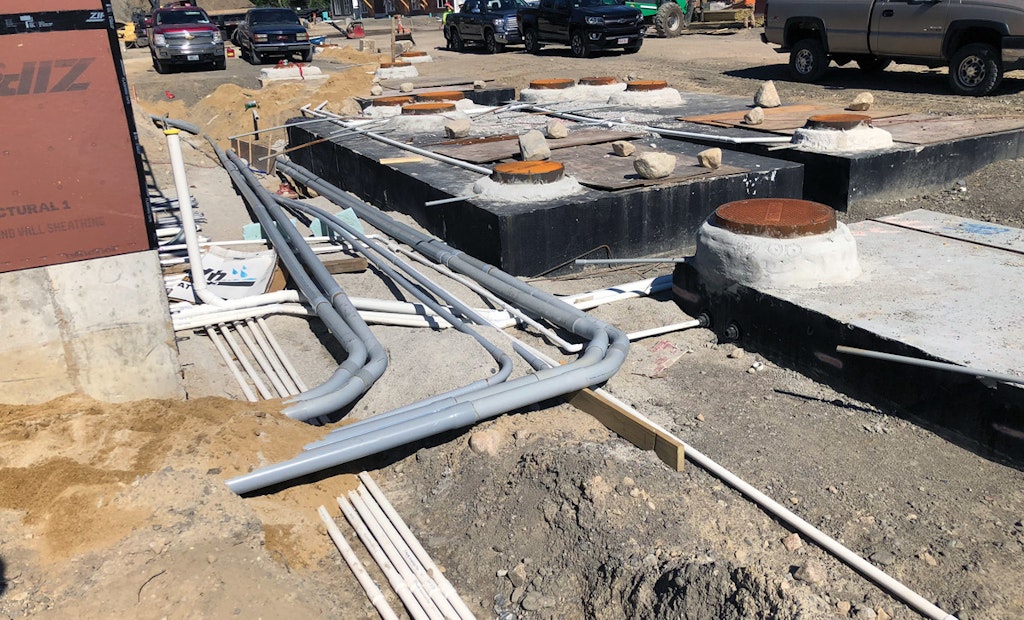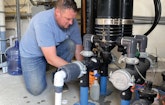
With the housing units under construction in the background, wastewater system construction was also underway. Blowers, suction pumps for membrane bioreactors, control panels, and filtration was centralized in a single building just visible at left. (Photos courtesy of J&R Sales and Service)
Interested in Systems/ATUs?
Get Systems/ATUs articles, news and videos right in your inbox! Sign up now.
Systems/ATUs + Get AlertsThe Noquochoke Village affordable housing project was first proposed for Westport, Massachusetts, in about 2005. In 2018, the wastewater system was installed as homes were being built.
“The challenge was for the developer to provide a solution that met all the town’s requirements, as well as maintain an aesthetic pleasing to the residents. The town has really tried to maintain that identity of a farming, rural, quiet seaside community,” says Lauren Usilton, president and owner of J&R Sales and Service in Raynham, Massachusetts. Her company supplied the onsite system for the project.
But as the process of approving the project went on, water quality standards changed. In the end, she says, there was only one solution for the project: a membrane bioreactor.
System details
From the collection system installed by East Coast Construction, wastewater flows into a 13,000-gallon concrete tank that serves as a lift station. Inside are Orenco duplex pumps moving about 50 gallons per minute.
Wastewater is conveyed about 50 feet through 2-inch pipe to a 20,000-gallon tank for settling and flow equalization. An 8-inch pipe then takes wastewater to a 10,000-gallon settling tank. On the 8-inch outlet pipe of this tank are four SaniTEE filters (BioMicrobics), two for each of the two treatment trains in the system.
Each train starts with an 8,000-gallon three-compartment tank. The first two compartments are anoxic. Each of those compartments is 2,000 gallons and holds a Goulds pump for mixing. The last compartment is a 4,000-gallon aerobic chamber with 16 membrane assemblies (eight double stacks). Suction for the membranes is provided from a central pump building.
Effluent is discharged to a 3,500-gallon pump chamber. In it are a pair of 20 gpm Goulds Blaster pumps that send water back to the pump building for additional filtration.
“Honestly, in this particular case it’s probably not needed because the membrane water is so clear. But it’s part of the Geoflow system to set pressure going out to the field,” Usilton says.
After the Geoflow filters, water is divided into a four-zone field of 16,384 square feet. In the field are 8,192 linear feet of Geoflow tubing laid at a depth of 8 to 10 inches.
Local nitrogen
J&R was brought in on the project as the local BioMicrobics representatives.
“We work with this engineer quite a bit, and we were contacted years ago,” Usilton says.
At that time, there were quite a few treatment options available, she says. Standard state limits applied then: 30 mg/L of BOD and TSS, and a nitrogen limit of 25 mg/L. Originally, the best option was a MicroFAST system, she says.
“And then as the development went through the town planning board and conservation, the nitrogen number requirement went lower and lower. So it went from 25 to 10, and then ultimately to 5,” she says.
When that happened, the BioBarrier was the only cost-effective option left for Noquochoke’s developer, she says.
That was not a requirement of the Massachusetts Department of Environmental Protection but of the local government.
“Nitrogen has always been a concern in Massachusetts,” she says. The first nitrogen management program started in the 1990s in cooperation with the U.S. Environmental Protection Agency. State standards typically are a minimum, meaning local governments can impose stricter limits.
“That’s exactly what Cape Cod has done,” Usilton says. “Since ’95, we’ve been installing the FAST systems on Cape Cod for nitrogen reduction.”
The town of Westport followed Cape Cod’s lead and imposed its own tight nitrogen limit. “They’re really looking at nitrogen and the concerns of nitrogen going into the Westport River,” she says.
Westport is on the southern coast of Massachusetts and borders Rhode Island. Its beaches are on the shore of Buzzards Bay, an arm of the Atlantic Ocean. The Buzzards Bay Coalition, a conservation group, has done several studies on nitrogen pollution in the bay, Usilton says. Although nitrogen is still a problem, water quality is better than it has been.
Saving hatches
Installation began in late summer of 2018, and the system was started up in May 2019. In between were the construction delays typical for any large project, she says.
Wastewater Treatment Services, which Usilton also leads, has the maintenance and operations contract for the system.
“We opted to manually add alkalinity [a 50-pound bag of sodium bicarbonate] by hand rather than use the feed system because it was just one less mechanical piece we needed to run,” she says. “And now that we have denitrification established, we don’t need the alkalinity feed system anymore.”
The system has an autodialer to warn technicians of problems, but there isn’t a full SCADA system with internet connectivity, she says. “We’ve found that nine times out of 10, we want to go out and look at it ourselves anyway.”
For the first six months, Massachusetts requires weekly inspections and monthly tests, and monthly inspection thereafter. In the beginning, technicians tweaked system operations about every two weeks, she says. For the past year, few adjustments have been needed except for slight adjustments to the MicroC feed system, depending on the influent.
To save space, engineers wanted to put all of the tanks in the parking area. Hatches give technicians access to the tanks, but the issue was how to preserve that.
“With having so many parking spaces for the residents, that was our concern: We were going to get there, and there was going to be somebody parked on the covers,” Usilton says. “Because what are you going to do, go knock on somebody’s door not knowing whose car it is?”
The solution was the two parking spaces designated for the building maintenance person. J&R told engineers which two hatches technicians must access, and the maintenance parking spaces were placed on top of those. If the maintenance person’s car is blocking access, it’s a simple matter to ask that the car be moved, she says.
“For us the unique part of this was that 5 mg/L limit. I don’t know how it is in other parts of the country, but less than 5 here is a unique number to get to. It’s not even required by most towns,” Usilton says. “And we’ve been pleasantly surprised by the operation of the system. Knowing that it was going to be a much more elaborate system, it’s really been fairly easy to operate and maintain really good effluent.”










